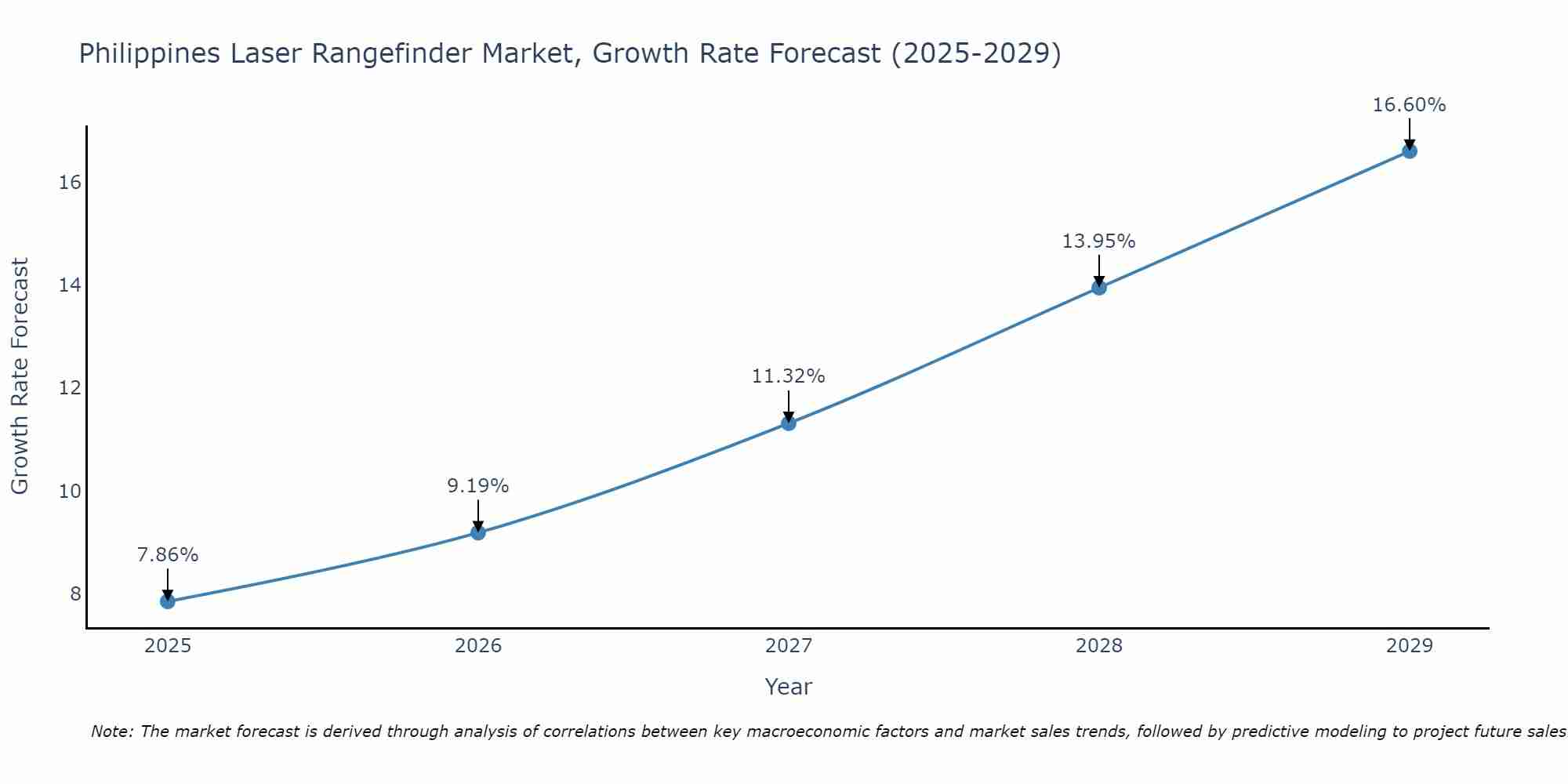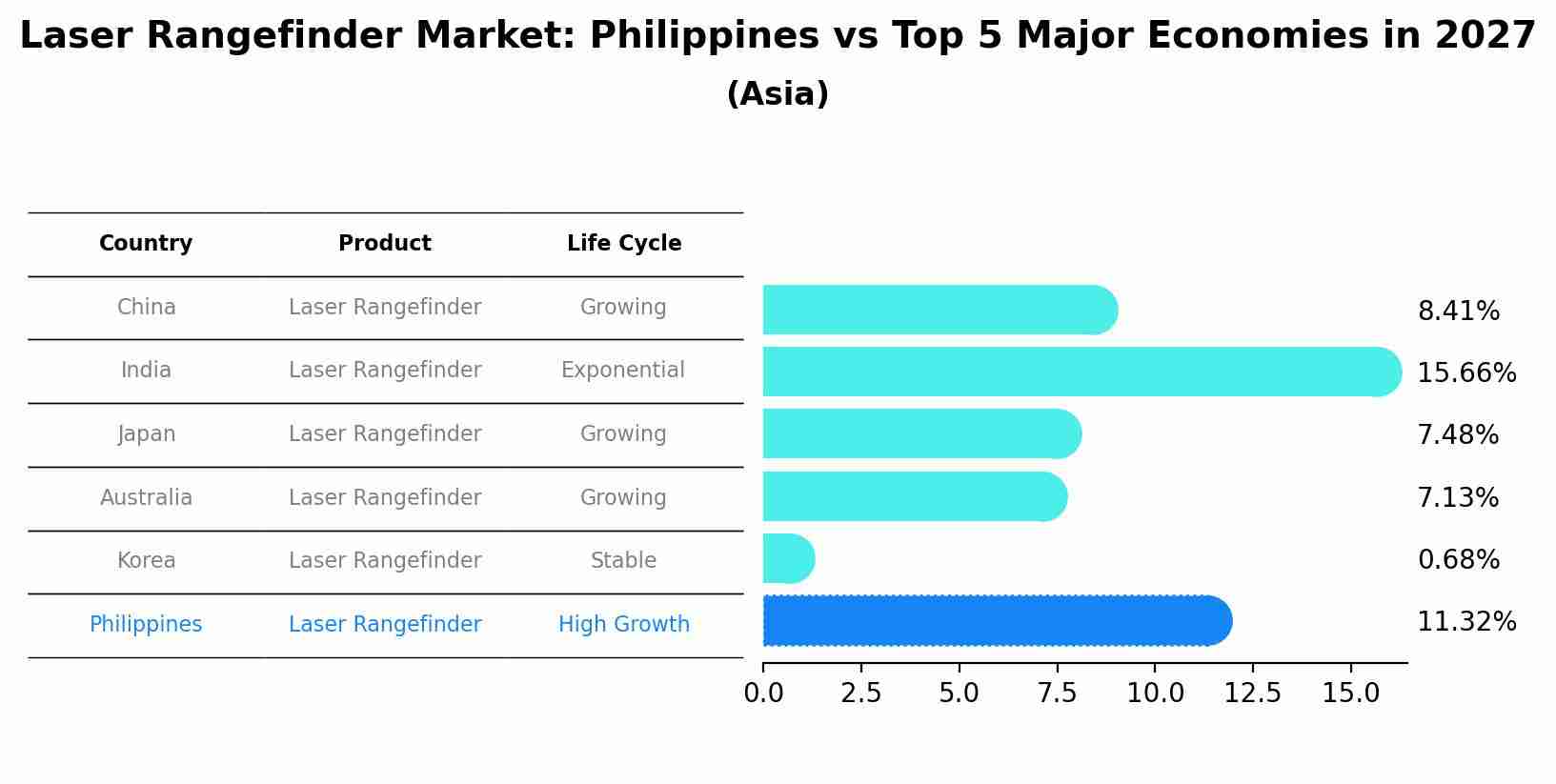Philippines Laser Rangefinder Market (2025-2031) Outlook | Value, Revenue, Industry, Share, Size, Trends, Analysis, Growth, Forecast & Companies
| Product Code: ETC365969 | Publication Date: Aug 2022 | Updated Date: Aug 2025 | Product Type: Market Research Report | |
| Publisher: 6Wresearch | No. of Pages: 75 | No. of Figures: 35 | No. of Tables: 20 | |
Philippines Laser Rangefinder Market Size Growth Rate
The Philippines Laser Rangefinder Market is poised for steady growth rate improvements from 2025 to 2029. The growth rate starts at 7.86% in 2025 and reaches 16.60% by 2029.

Laser Rangefinder Market: Philippines vs Top 5 Major Economies in 2027 (Asia)
By 2027, Philippines's Laser Rangefinder market is forecasted to achieve a high growth rate of 11.32%, with China leading the Asia region, followed by India, Japan, Australia and South Korea.

philippines laser rangefinder market Synopsis
The laser defense eyewear market in the Philippines is anticipated to experience moderate growth due to increasing awareness about the potential hazards of laser exposure. As various industries, including defense, medical, and industrial sectors, employ lasers, the need for protective eyewear grows. The market is expected to grow at a CAGR of around 4. 5%, driven by stringent safety regulations and the need to ensure worker safety.
Drivers of the Market
In the laser rangefinder market, the Philippines is experiencing growth driven by several key factors. The construction and surveying industries are witnessing expansion due to urbanization and infrastructure development projects, leading to a higher demand for accurate distance measurement tools. Similarly, the defense sector`s modernization efforts necessitate advanced equipment, including laser rangefinders, for precise targeting and reconnaissance. Moreover, the utilization of laser rangefinders in outdoor sports and recreational activities further contributes to market growth. As the technology continues to evolve, offering enhanced accuracy and versatility, its adoption is expected to surge, propelling the market forward.
Challenges of the Market
The laser rangefinder market in the Philippines faces obstacles related to accuracy and reliability. Factors such as weather conditions, reflective surfaces, and interference can impact the precision of distance measurements. Calibrating rangefinders to deliver consistent performance across various environments can be technically challenging.
COVID-19 Impact on the Market
The impact of the pandemic on the Philippines laser rangefinder market was characterized by shifts in consumer behavior and preferences. With restrictions on travel and outdoor activities, the demand for certain types of laser rangefinders, such as those used for recreational purposes like golf and hunting, experienced a temporary decline. However, there was a simultaneous uptick in the use of rangefinders for more industrial applications, such as construction and surveying, as these sectors continued to operate during the pandemic.
Key Players in the Market
Major players in this market might include Leica Geosystems, Trimble, Bushnell, and other manufacturers specializing in measurement and optical instruments.
Key Highlights of the Report:
- Philippines Laser Rangefinder Market Outlook
- Market Size of Philippines Laser Rangefinder Market, 2024
- Forecast of Philippines Laser Rangefinder Market, 2031
- Historical Data and Forecast of Philippines Laser Rangefinder Revenues & Volume for the Period 2021-2031
- Philippines Laser Rangefinder Market Trend Evolution
- Philippines Laser Rangefinder Market Drivers and Challenges
- Philippines Laser Rangefinder Price Trends
- Philippines Laser Rangefinder Porter's Five Forces
- Philippines Laser Rangefinder Industry Life Cycle
- Historical Data and Forecast of Philippines Laser Rangefinder Market Revenues & Volume By Type for the Period 2021-2031
- Historical Data and Forecast of Philippines Laser Rangefinder Market Revenues & Volume By Telescope Later Rangefinder for the Period 2021-2031
- Historical Data and Forecast of Philippines Laser Rangefinder Market Revenues & Volume By Hand-held Later Rangefinder for the Period 2021-2031
- Historical Data and Forecast of Philippines Laser Rangefinder Market Revenues & Volume By Application for the Period 2021-2031
- Historical Data and Forecast of Philippines Laser Rangefinder Market Revenues & Volume By Military for the Period 2021-2031
- Historical Data and Forecast of Philippines Laser Rangefinder Market Revenues & Volume By Construction for the Period 2021-2031
- Historical Data and Forecast of Philippines Laser Rangefinder Market Revenues & Volume By Industrial for the Period 2021-2031
- Historical Data and Forecast of Philippines Laser Rangefinder Market Revenues & Volume By Sports for the Period 2021-2031
- Historical Data and Forecast of Philippines Laser Rangefinder Market Revenues & Volume By Forestry for the Period 2021-2031
- Historical Data and Forecast of Philippines Laser Rangefinder Market Revenues & Volume By Others for the Period 2021-2031
- Philippines Laser Rangefinder Import Export Trade Statistics
- Market Opportunity Assessment By Type
- Market Opportunity Assessment By Application
- Philippines Laser Rangefinder Top Companies Market Share
- Philippines Laser Rangefinder Competitive Benchmarking By Technical and Operational Parameters
- Philippines Laser Rangefinder Company Profiles
- Philippines Laser Rangefinder Key Strategic Recommendations
Frequently Asked Questions About the Market Study (FAQs):
- Single User License$ 1,995
- Department License$ 2,400
- Site License$ 3,120
- Global License$ 3,795
Search
Related Reports
- ASEAN and Thailand Brain Health Supplements Market (2025-2031) | Strategy, Consumer Insights, Analysis, Investment Trends, Opportunities, Growth, Size, Share, Industry, Revenue, Segments, Value, Segmentation, Supply, Forecast, Restraints, Outlook, Competition, Drivers, Trends, Demand, Pricing Analysis, Competitive, Strategic Insights, Companies, Challenges
- ASEAN Bearings Market (2025-2031) | Strategy, Consumer Insights, Analysis, Investment Trends, Opportunities, Growth, Size, Share, Industry, Revenue, Segments, Value, Segmentation, Supply, Forecast, Restraints, Outlook, Competition, Drivers, Trends, Demand, Pricing Analysis, Competitive, Strategic Insights, Companies, Challenges
- Europe Flooring Market (2025-2031) | Outlook, Share, Industry, Trends, Forecast, Companies, Revenue, Size, Analysis, Growth & Value
- Saudi Arabia Manlift Market (2025-2031) | Outlook, Size, Growth, Trends, Companies, Industry, Revenue, Value, Share, Forecast & Analysis
- Uganda Excavator, Crane, and Wheel Loaders Market (2025-2031) | Strategy, Consumer Insights, Analysis, Investment Trends, Opportunities, Growth, Size, Share, Industry, Revenue, Segments, Value, Segmentation, Supply, Forecast, Restraints, Outlook, Competition, Drivers, Trends, Demand, Pricing Analysis, Competitive, Strategic Insights, Companies, Challenges
- Rwanda Excavator, Crane, and Wheel Loaders Market (2025-2031) | Strategy, Consumer Insights, Analysis, Investment Trends, Opportunities, Growth, Size, Share, Industry, Revenue, Segments, Value, Segmentation, Supply, Forecast, Restraints, Outlook, Competition, Drivers, Trends, Demand, Pricing Analysis, Competitive, Strategic Insights, Companies, Challenges
- Kenya Excavator, Crane, and Wheel Loaders Market (2025-2031) | Strategy, Consumer Insights, Analysis, Investment Trends, Opportunities, Growth, Size, Share, Industry, Revenue, Segments, Value, Segmentation, Supply, Forecast, Restraints, Outlook, Competition, Drivers, Trends, Demand, Pricing Analysis, Competitive, Strategic Insights, Companies, Challenges
- Angola Excavator, Crane, and Wheel Loaders Market (2025-2031) | Strategy, Consumer Insights, Analysis, Investment Trends, Opportunities, Growth, Size, Share, Industry, Revenue, Segments, Value, Segmentation, Supply, Forecast, Restraints, Outlook, Competition, Drivers, Trends, Demand, Pricing Analysis, Competitive, Strategic Insights, Companies, Challenges
- Israel Intelligent Transport System Market (2025-2031) | Strategy, Consumer Insights, Analysis, Investment Trends, Opportunities, Growth, Size, Share, Industry, Revenue, Segments, Value, Segmentation, Supply, Forecast, Restraints, Outlook, Competition, Drivers, Trends, Demand, Pricing Analysis, Competitive, Strategic Insights, Companies, Challenges
- Uganda Precast and Aggregate Market (2025-2031) | Strategy, Consumer Insights, Analysis, Investment Trends, Opportunities, Growth, Size, Share, Industry, Revenue, Segments, Value, Segmentation, Supply, Forecast, Restraints, Outlook, Competition, Drivers, Trends, Demand, Pricing Analysis, Competitive, Strategic Insights, Companies, Challenges
Industry Events and Analyst Meet
Our Clients
Whitepaper
- Middle East & Africa Commercial Security Market Click here to view more.
- Middle East & Africa Fire Safety Systems & Equipment Market Click here to view more.
- GCC Drone Market Click here to view more.
- Middle East Lighting Fixture Market Click here to view more.
- GCC Physical & Perimeter Security Market Click here to view more.
6WResearch In News
- Doha a strategic location for EV manufacturing hub: IPA Qatar
- Demand for luxury TVs surging in the GCC, says Samsung
- Empowering Growth: The Thriving Journey of Bangladesh’s Cable Industry
- Demand for luxury TVs surging in the GCC, says Samsung
- Video call with a traditional healer? Once unthinkable, it’s now common in South Africa
- Intelligent Buildings To Smooth GCC’s Path To Net Zero













